Sep 19, 2019
Jindaiji Temple in Chofu: It's Tokyo but not as you've seen it before
Ancient Jindaiji Temple in the city of Chofu, in western Tokyo, offers visitors a rare and complete escape from the hurried pace of the Japanese capital, despite the temple’s easy access from one of Tokyo’s busiest transport hubs. With all that Jindaiji Temple has to offer visitors can spend a rewarding half-day here. More if the temple’s surrounding attractions are included.
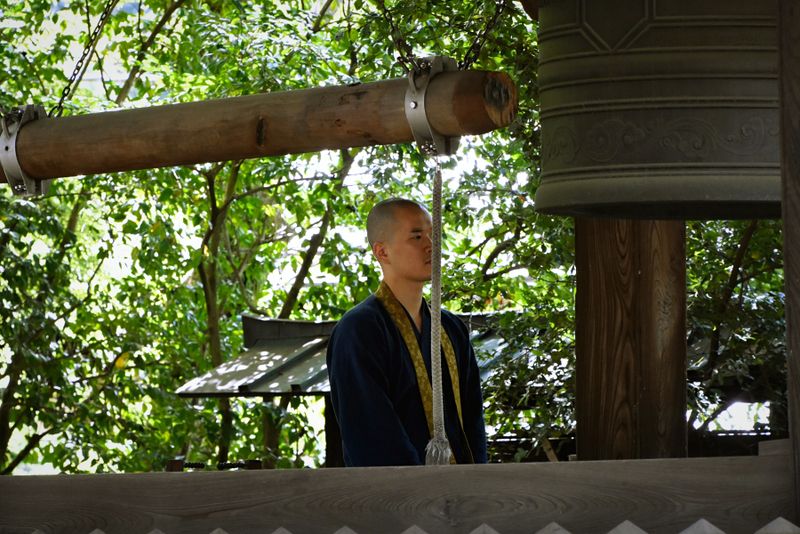
The Buddhist temple of Jindaiji belies its location just a short train journey from Shinjuku, in the city of Chofu. To enter the grounds of this around 1,300-year-old temple in western Tokyo is to feel so far removed from the neon-lit chaos of the Japanese capital as to have you believe you’d entered a different world entirely. An enchanting one at that.
In fact the magic of Chofu's Jindaiji spreads beyond its borders cloaking the surrounding streets in the kind of quiet Japanese charms and comforting greenery that the Japan traveler might have come to expect from the best bits of Kyoto, before the crowds rolled in. But this is still Tokyo, just not as we knew it could ever be.
From the grounds proper of Jindaiji Temple and the ancient treasures within, through the trees and past the trickling streams that hide them, to the cafes, craft stores and soba restaurants that dot the area visitors here will easily lose half a day, if not a grasp of time itself.
Just be warned, when you eventually drag yourself away and back into the boom and bustle of the Tokyo you knew prior, it might come as a bit of a rude shock. But don’t worry, the Jindaiji experience is emphatically worth it.
Having been around since 733 it’s understandable that word is already out about Jindaiji Temple in Chofu. That’ll happen when you see passers through that include the likes of a Tokugawa shogun, so some stories go!
So it is that for this visit to Jindaiji we arrived early-in-the-day to be rewarded with an all-consuming serenity that brings out the best in places like this. We’re not spiritual ourselves, but this is probably as close as we can get.
Buses from Chofu Station to Jindaiji drop at the main entrance to the Sando -- the avenue marking the approach to Jindaiji Temple -- where there’s a small information kiosk just off to the left.
Early doors and the shops lining the quaint approach were just stirring in preparation for the day ahead. Not to worry. They could be saved for later. Instead we headed through Jindaiji’s main gate and into the grounds, taking pause at the gate -- the Sanmon -- at over 300 years, the oldest of Jindaiji’s surviving structures.
The Main Hall
Those who like to cover all the bases during a temple visit might want to light some osenko (incense) and place it in the large burner in front of Jindaiji’s Main Hall -- the Hondou. The smoke is believed to have healing powers so waft it toward wherever you feel it might be needed. (We went for the head in the hopes it might make us smarter -- maybe a lost cause though!)
Jindaiji’s Main Hall emerges from the trees to lord over the grounds. In its current guise the structure dates back to 1919 (rebuilt after being destroyed by fire) but the history of this temple goes back long enough to have given birth to legend.
In the case of Jindaiji it’s legend of two lovers separated by class and disapproving parents. Prayers to the temple’s namesake, Jinja Daioh (the god of water), were heard, the lovers were reunited and the reluctant parents allowed the two to marry. Their child, the monk Mankhoo Shonin, founded Jindaiji Temple and here Jinja Daioh is enshrined, so the legend goes.
The story has given Jindaiji something of a reputation as a matchmaker, and while we’re all set in that regard, we offered a quiet moment in front of the main hall in the hopes that Jindaiji's resident spirits might at least keep the waters of our relationship as smooth as possible! Let’s see how we go.

(Jindaiji's Main Hall, the Hondou)
On raised ground beyond the Hondou is Ganzandaishi Hall in which a monk of the same name is enshrined.
Ganzandaishi is said to have created the custom of 'omikuji,' those fortune-telling slips that are often found at temples across Japan. Outside the entrance to the hall then, are boxes of the things. Some of the omikuji are in the form of daruma, in different colors, inside of which is the fortune, to our delight written in English. Turns out things were looking pretty rosy for this Jindaiji visitor on that particular day.
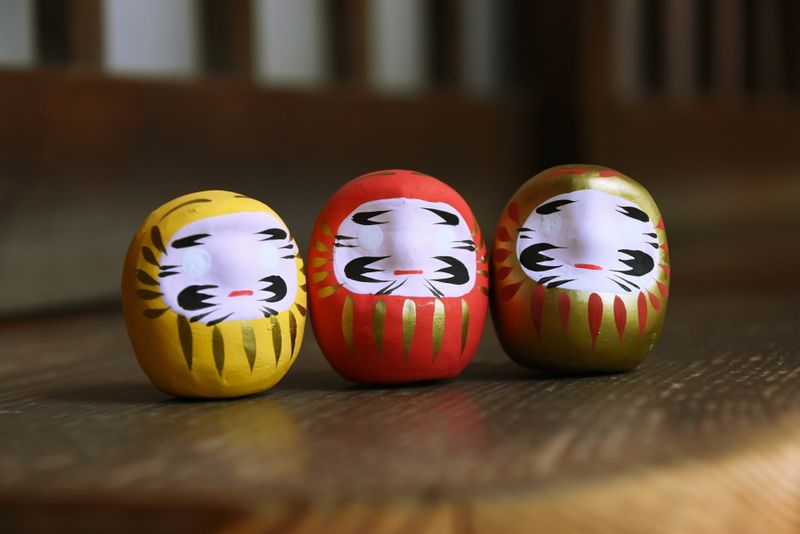
Whatever the outlook though the daruma make for cute souvenirs and look great in a line up with their mates!
Gomadaki
Jindaiji may have been established to enshrine a god of water but it’s fire that comes to the fore during the ritual of 'Gomadaki' -- a haunting experience that only lends to Jindaiji’s otherworldly nature.
Gomadaki rituals are scheduled throughout the day at the Ganzandaishi Hall during which the temple’s monks perform a ritual burning of offerings and prayers written on 'gomagi,' or 'gomafuda.'
In preparation for the ritual we wrote our names and prayers on the gomagi placed outside the entrance to the hall. Instructions are in English but the process is simple enough -- name on one side, wishes / prayers on the other and then put them in the box from which they will be collected.
The hard part for some might be deciding what to pray for. Feeling like “world peace” had probably been well covered by that point, we went with something about “surfing and a happy life.” A little selfish maybe, but we decided to let someone else be the judge of that.
Light quips aside, the gomadaki ritual at Jindaiji Temple in Chofu is spine-tingling stuff. Eight monks filed into the hall, the head monk taking a position in the center, one monk tending to a fire in the corner and our gomagi, another poised in front of a large drum. We were on the floor trying to deal with an awkward set of legs.
We can’t even pretend to know exactly what was going on, in part because the gradual build-up of drum beats, chimes and chants served to dispel any questions of the here and now, even the one about the most comfortable sitting position. Jindaiji was casting its spell ever wider, ever deeper.
As the chatting continued to build in intensity we could see the monk in front of the fire dealing with our gomagi in the flurry of flames and his own intricate hand gestures. This observer felt a pang of shame at selfish surfing desires and was quietly relieved to see the evidence go up in flames.

(Gomadaki ritual at Jindaiji Temple, Chofu)
The ritual concluded as one of the monks lead us through what we took to be a prayer before the head monk stepped forward, the ancient tone offset by his modern microphone, and invited us to make ourselves comfortable.
He explained, in Japanese, a little about what had just taken place, about the spirit of the Kannon, the bodhisattva of compassion, being present in all of us. In contrast, so too are the desires for worldly possessions, and our negative passions, our 'bonou.' The fire, the burning was a symbolic cleansing. The desires and passions will return, we were told, but our visit to Jindaiji, the ritual, even the instabae daruma, are reminders for us to keep them under control.
It’s funny to think that the stage of the Ganzandaishi Hall had, for an unknown number of years, been hiding what is now said to be the oldest statue of a seated Buddha in Eastern Japan -- the Hakuhoh Buddha.
Hakuhoh Buddha
Now designated a National Treasure the Hakuhoh Buddha sits tantalizingly out of reach beyond a pane of glass in Jindaiji’s Shaka Hall. Actually, 'tantalizing' is probably a poor choice of words given the setting and the object of our gaze -- a peaceful repose in gilded bronze that has remained seated and calm for around as long as Jindaiji, over 1,300 years.
Taking photos of Hakuhoh Buddha is prohibited. Probably a good thing as most of them could never do it justice.
While Main Hall, Ganzandaishi Hall, and Shaka Hall are are likely to form the centerpiece of Jindaiji’s tangible appeals for many, the temple grounds have much more to explore and discover, particularly along the quiet pathways west of the main structures.
Here we particularly enjoyed the statues of Daikokuten and Ebisu-son looking portly and pleased with themselves taking shelter in the beautiful structure in the southwestern corner of the temple complex.
Tucked away on a quiet path, the other side of a forested glade west of the main cluster of Jindaiji’s structures, keep a lookout for the small cave housing a large stone featuring an engraving of Enmei Kannon. Remarkably, the engraving was discovered when the stone was lifted out of the ocean during the construction of Kishikata Port in Akita Prefecture, in 1966.
Raku-yaki
We took a left out of Jindaiji’s Sanmon Gate and walked across the charming street that fronts the temple complex to Musashino Jindaiji Gama, a ceramic workshop and store where visitors can try their hand at raku-yaki, or raku ware, or at least the painting of it in this case.
Musashino Jindaiji Gama has been around since 1957 and in all those years we’d venture to say that our own efforts at decorating their beautiful raku ware probably rank among the worst. When it’s this much fun though, who cares?!

(Artist at work! Raku-yaki experience around Jindaiji Temple, Chofu)
The set up is simple -- choose from a range of cups, bowls, and figures awaiting a flourish of color, from a set of shelves in the center of the store. Then take your item of choice to the benches where pencils and paint await and get decorating.
When finished staff will take your item, glaze it and bake it in their raku ware kiln where the direct flame will remove any pencil marks that you might have made. It takes around 20 minutes for the baking process to be complete.
In the meantime then …
Lunch
Think food at Jindaiji Temple in Chofu, think Jindaiji soba, the area’s own take on the light brown buckwheat noodles that those familiar with Japanese culture might associate with eating at the turn of the year.
There are almost 30 eateries around Jindaiji where diners can tuck into the celebrated soba noodles.
We headed for Matsuba Chaya a short climb north of Jindaiji, heading towards Jindai Botanical Gardens. The Jindaiji soba restaurant has a charming cabin-in-the-woods feel to it, so much so that the trunk of a mighty oak tree protrudes out of the center of the restaurant!
Over a bowl of the classic 'tenzaru soba' -- cold soba noodles served with pieces of tempura -- the owner of Matsuba Chaya did his best to cram around 400 years of Jindaiji’s relationship with soba into the short time it took me to wolf down my lunch. (Too delicious to hold back.)
As opposed to that most Japanese of staples, rice, apparently the earth around Jindaiji lends itself more to the cultivation of buckwheat. During the Edo Era monks at Jindaiji used the flour from buckwheat to make the noodles. Such was their skill at this, the noodles created by the monks even garnered the praise of one Tokugawa Ieyasu, founder of the Tokugawa shogunate, so one story goes.
Once something eaten by the elite then, word spread about the soba noodles of Jindaiji in the late Edo Era, and the dish became popular with travelers passing through the Musashino area. It’s probably a good thing that the noodles became popular among the masses as there was little that could be considered 'elite' about the way in which we wolfed them down.
And while our praise probably doesn’t compare to that of shogun, we were happy to dish it out anyway.
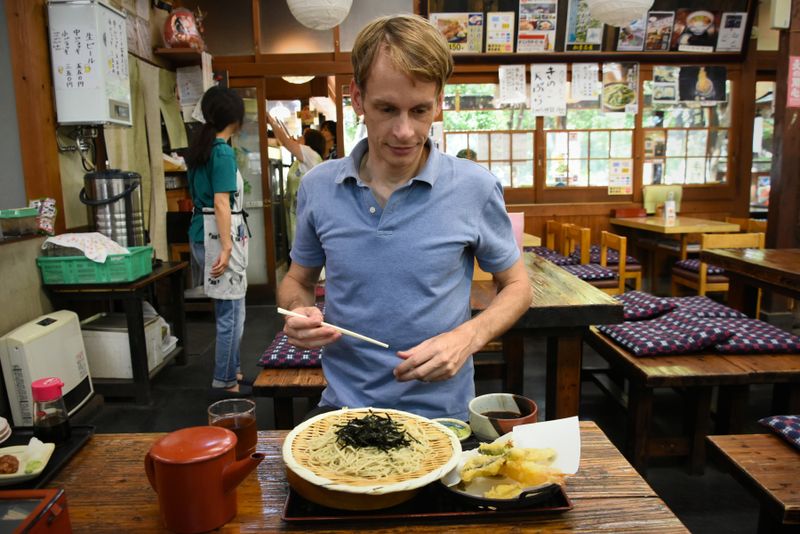
(Where to start? Contemplating Jindaiji soba-eating strategy at Matsuba Chaya)

(Water is a key feature of Jindaiji Temple, Chofu)
Note: Water is a key feature of the Jindaiji landscape, trickling along rocky streams and gathering in pleasant ponds. This same water may have been used to rinse the monk’s soba noodles back in the day. On the main road heading west from the entrance to Jindaiji’s Sando look out for the charming Chofu Jindaiji Temple Water Mill House were you can see an example of how the water was put to work in grinding the buckwheat into flour.
Jindai Botanical Gardens
If the visitor could lose track of time at Jindaiji Temple in Chofu, they could get lost altogether in the neighboring Jindai Botanical Gardens, all 490,000-sq. meters of it -- plenty of room to stretch the legs and walk off the lunch!
Temple and gardens appeared to blend almost seamlessly as we entered through the Jindaijimon Gate along the gardens’ southern edge, Jindaiji continuing to keep the city but a distant memory.
At the entrance be sure to pick up a pamphlet (English available) that details which of the some 100,000 plants and trees in Jindai Botanical Gardens are putting on the best show given the season. Oh, and the map is easy to read, so you won’t actually get lost!
During our visit we had fun comparing our own height to that of the large cluster of pampas grass sprouting from the center of the gardens’ Lawn Square and when we were done with exploring other areas of the gardens we took a pew under the large roofing at the eastern end of the Rose Garden and contemplated the scale of the greenhouse at the other end.
Note: September / October is the best time to see the pampas grass at Jindai Botanical Gardens in its full splendor.
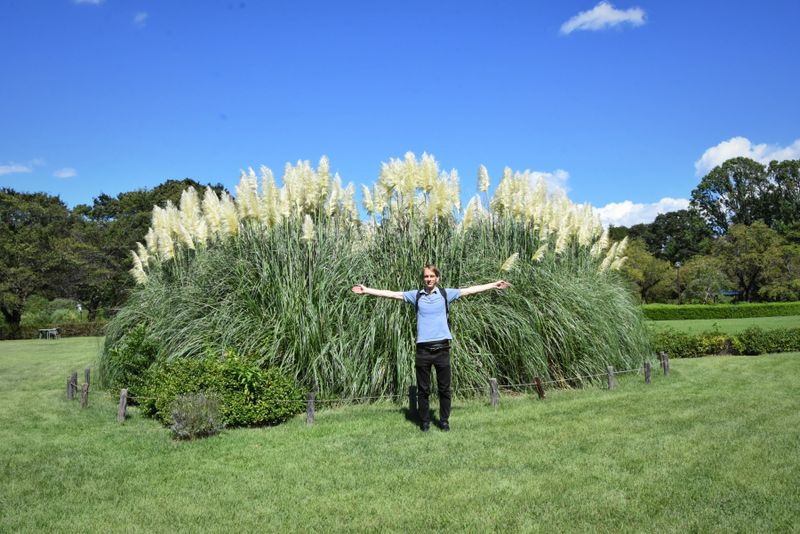
(Measuring the pampas grass, Jindai Botanical Gardens, Chofu)
From the gardens we headed back towards Jindaiji to collect our raku ware and make one final stop …
Kitaro Chaya
Throughout the city of Chofu visitors can spot reminders that this is "Mizuki Manga's birthplace." And Jindaiji is no exception.
Mizuki Manga is the moniker given to the works, and the fantastical world, created by manga artist and honorary Chofu citizen Shigeru Mizuki.
Among the most celebrated of Mizuki’s works is the manga GeGeGe no Kitaro the central protagonist of which, Kitaro, is a one-eyed Yokai boy seeking to unite the world of humans with that of the Yokai (spirit monsters).
A model of Kitaro stands outside the store at the southern end of Jindaiji’s Sando approach making Kitaro Chaya easy to spot.
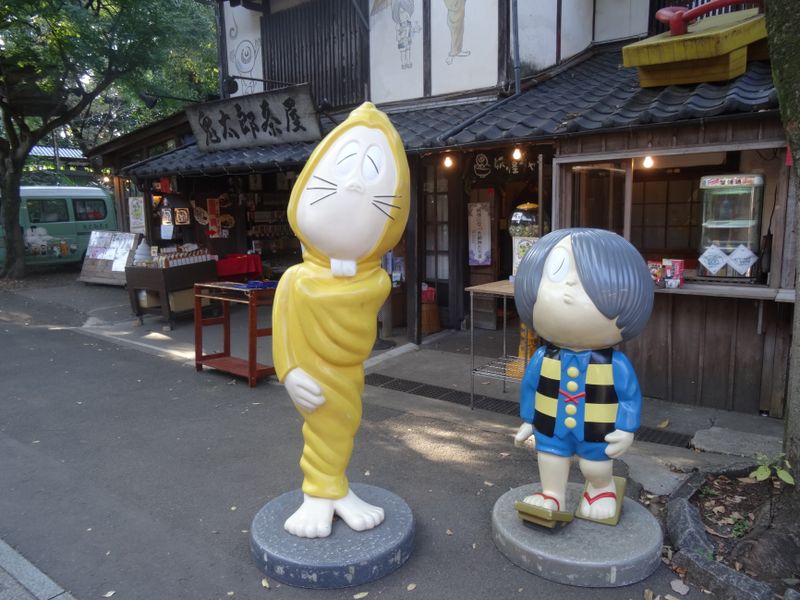
©Mizuki Productions
Inside Kitaro Chaya lies a delightful treasure trove of trinkets and tributes to the much-loved manga including stationery, mugs, sake and, of course, manga.
The cafe at the rear of the store explains in manga form the seating and ordering system of the cafe, where the menu’s sweets come with decorated with Yokai motifs.
Ancient temple and popular manga might seem an unlikely combination at first glance, but for us a visit to Kitaro Chaya was a fitting end to time spent in and around Jindaiji, and would complement a temple visit at any stage -- both take the visitor to new worlds, so close to that from which they came, but sensationally so far removed.
Visiting Jindaiji Temple and around
On this particular visit to Jindaiji Temple we arrived at around 9:30. Including above surrounding spots and activities, we departed the area for Chofu Station at around 15:00
Access from Chofu Station
For this trip we took a local bus departing stop No. 14 outside of Chofu Station’s Hiroba Exit -- take a right out of the exit and look for the Parco department store. Stop. 14 is across the road. Look for buses marked ‘cho 34’ (調34). They drop at the entrance to Jindaiji’s Sando - you can’t miss it. The fare was 210 yen one-way.
Buses from Chofu Station to Jindaiji Temple take around 15 minutes. On our bus stops were listed in English on a screen at the front of the bus.
Gomadaki and omikuji at Ganzandaishi Hall
Gomadaki -- ritual and talk -- takes around 30 mins. Gomagi sticks cost 300 yen each and are available at the entrance to the hall. Have it ready for collection before the gomadaki start time.
Times: 11:00, 14:00 (weekdays) / 11:00, 13:00, 14.00 (Sat, Sun, holidays)
Daruma omikuji cost 300 yen. Others 200 yen.
Shaka Hall and Hakuhoh Buddha
The Hakuhoh Buddha can be viewed from 9:00 - 17:00 (March 21 - Sept. 22), 9:00 - 16:00 (Sept. 23 - March 20).
Admission is 300 yen (placed in the collection box in front of the display).
Raku-yaki at Musashino Jindaiji Gama
Items to choose from for raku-yaki include stands for chopsticks, small plates, cups and items for tea ceremony. Prices for items range from 250 yen to ~ 3,000 yen.
Hours (reception): 9:00 - 16:00 (store open until 17:00)
Address: 5-13-6 Jindaiji Motomachi
Map: Link to Google Maps
Web (Japanese): http://jindaijigama.com/index.html
Matsuba Chaya
Hours: 10:00 - 17:00
Closed: Mondays (or following Tuesday if public holiday)
Menu: Available in English
Address: 5-11-3 Jindaiji Motomachi, Chofu-shi, Tokyo
Map: Link to Google Maps
Web (Japanese): https://www.matsuba-jindaiji.com/
Jindai Botanical Gardens
Hours: 9:30 - 17:00 (Last admission to main garden 16:00 / Aquatic Plant Garden closes 16:30)
Closed: Mondays (or following Tuesday if public holiday) and Year-end holidays (Dec. 29 - Jan. 1)
Entrance: General 500 yen / 65 or over 250 yen / Children 200 yen
Address: 5-31-10 Jindaiji Motomachi, Chofu-shi, Tokyo
Map: Link to Google Maps
Web: http://www.tokyo-park.or.jp/park/format/index045.html
Kitaro Chaya
Hours: 10:00 - 17:00 (cafe food service stops 16:30 / Last admission to gallery 16:45)
Closed: Mondays (or following Tuesday if public holiday)
Address: 5-12-8 Jindaiji Motomachi, Chofu-shi, Tokyo
Map: Link to Google Maps
Web (Japanese): http://kitaro-chaya.jp/
This article was supported by Chofu City.




0 Comments